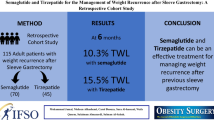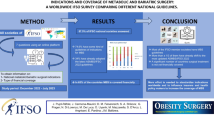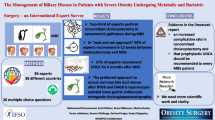Abstract
Background
Laparoscopic sleeve gastrectomy (SG) is a popular bariatric procedure for treating morbid obesity. This study aimed to investigate the relation between SG and lipid metabolism in an obese diabetic rat model.
Methods
Forty-five male Zucker diabetic fatty (ZDF) rats were divided into three groups: sham-operated (SO) control, gastric banding (GB), and SG. Six weeks after surgery, metabolic parameters, including plasma adiponectin level, small bowel transit, mRNA expression of peroxisome proliferator-activated receptor (PPAR)-α and PPARγ in the liver, skeletal muscle and white adipose tissue, and that of adiponectin in white adipose tissue, and triglyceride (TG) contents in the liver and skeletal muscle were measured.
Results
Metabolic parameters in the GB and SG groups were significantly improved compared with those in the SO group. However, plasma total cholesterol (TC) and free fatty acid (FFA) concentrations were significantly lower while the plasma adiponectin level was significantly higher in the SG group than in the GB and SO groups. In addition, small bowel transit time was significantly shorter in the SG group than in the other two groups. Furthermore, in the SG group, mRNA expression of PPARα in the liver and skeletal muscle and that of adiponection and PPARγ in white adipose tissue were significantly higher, while TG in the liver and skeletal muscle were significantly lower, compared with those in the other two groups.
Conclusions
These results suggest that SG improves lipid metabolism compared with GB, although there were no significant differences in the effect on weight loss between the two procedures.






Similar content being viewed by others
References
Kopelman PG. Obesity as a medical problem. Nature. 2000;404:635–43.
Strum R. Increases in morbid obesity in the USA: 2000–2005. Public Health. 2007;121:492–6.
Sjostrom L, Lindroos AK, Peltonen M, et al. Lifestyle, diabetes, and cardiovascular risk factors 10 years after bariatric surgery. N Engl J Med. 2004;351:2683–93.
Steinbrook R. Surgery for severe obesity. N Engl J Med. 2004;350:1075–9.
Buchwald H, Oien DM. Metabolic/bariatric surgery worldwide 2008. Obes Surg. 2009;19:1605–11.
Himpens J, Dobbeleir J, Peeters G. Long-term results of laparoscopic sleeve gastrectomy for obesity. Ann Surg. 2010;252:319–24.
Gluck B, Mobitz B, Jansma S, et al. Laparoscopic sleeve gastrectomy is a safe and effective bariatric procedure for lower BMI (35.0-43 kg/m2) population. Obes Surg. 2011;21:1168–71.
Shah S, Shah P, Todkar J, et al. Prospective control study of effect of laparoscopic sleeve gastrectomy on small bowel transit time and gastric emptying half-time in morbidly obese patients with type 2 diabetes mellitus. Surg Obes Relat Dis. 2010;6:152–7.
Masuda T, Ohta M, Hirashita T, et al. A comparative study of gastric banding and sleeve gastrectomy in an obese rat model. Obes Surg. 2011;21:1774–80.
Issemann I, Green S. Activation of a number of the steroid hormone receptor superfamily by peroxisome proliferators. Nature. 1990;18:645–50.
Lemberger T, Desvergne B, Wahli W. Peroxisome proliferator-activated receptor signaling pathway in lipid physiology. Annu Rev Cell Dev Biol. 1996;12:335–63.
Toyoda T, Kamei Y, Kato H, et al. Effect of peroxisome proliferator-activated receptor-α ligands in the interaction between adipocytes and macrophages in obese adipose tissue. Obesity. 2008;16:1199–207.
Tontonoz P, Hu E, Spiegelman BM. Stimulation of adipogenesis in fibroblasts by PPAR gamma 2, a lipid-activated transcription factor. Cell. 1994;79:1147–56.
Endo Y, Ohta M, Kai S, et al. An obese rat model of bariatric surgery with gastric banding. Obes Surg. 2007;17:815–9.
Endo Y, Ohta M, Hirashita T, et al. Additional effect of visceral fat resection in an obese rat model of gastric banding. Obes Surg. 2009;157:243–50.
Lopez PP, Nicholson SE, Burkhardt GE, et al. Development of a sleeve gastrectomy weight loss model in obese Zucker rats. J Surg Res. 2009;157:243–50.
Mattews DR, Hosker JP, Rudenski AS, et al. Homeostasis model assessment: insulin resistance and beta-cell function from fasting plasma glucose and insulin concentrations in man. Diabetologia. 1985;28:412–9.
Suzuki S, Ramos EJB, Goncalves CG, et al. Changes in GI hormones and their effect on gastric emptying and transit times after Roux-en-Y gastric bypass in rat model. Surgery. 2005;138:283–90.
Yamada Y, Kato T, Ogino H, et al. Cetilistat (ATL-962), a novel pancreatic lipase inhibitor, ameliorates body weight gain and improves lipid profiles in rats. Horm Metab Res. 2008;40:539–43.
Tominaga M, Ohta M, Kai S, et al. Increased heat shock protein 90 expression contributes to impaired adaptive cytoprotection in the gastric mucosa of portal hypertensive rats. J Gastroenterol Hepatol. 2009;24:1136–41.
Arakawa M, Masaki T, Nishimura J, et al. The effects of branched-chain amino acid granules on the accumulation of tissue triglycerides and uncoupling proteins in diet-induced obese mice. Endocrinol J. 2011;58:161–70.
Schauer PR, Kashyap SR, Wolski K, et al. Bariatric surgery versus intensive medical therapy in obese patients with diabetes. N Engl J Med. 2012;366:1567–76.
Sirbu A, Copăescu C, Martin S, et al. Six months results of laparoscopic sleeve gastrectomy in treatment of obesity and its metabolic complications. Chir (Bucur). 2012;107:469–75.
Bohdjalian A, Langer FB, Shakeri-Leidenmühler S, et al. Sleeve gastrectomy as sole and definitive bariatric procedure: 5-year results for weight loss and ghrelin. Obes Surg. 2010;20:535–40.
Deitel M, Gagner M, Erickson AL, et al. Third International Summit : current status of sleeve gastrectomy. Surg Obes Relat Dis. 2011;7:749–59.
Bellanger DE, Greenway FL. Laparoscopic sleeve gastrectomy, 529 cases without a leak: short-term results and technical considerations. Obes Surg. 2011;21:146–50.
Manenacos E, Stamou KM, Albanopoulos K, et al. Laparoscopic sleeve gastrectomy performed with intent to treat morbid obesity: a prospective single-center study of 261 patients with a median follow-up 1 year. Obes Surg. 2010;20:276–82.
Chambers AP, Jessen L, Ryan KK, et al. Weight-independent changes in blood glucose homeostasis after gastric bypass or vertical sleeve gastrectomy in rats. Gastroenterology. 2011;141:950–8.
Hady HR, Dadan J, Gołaszewski P, et al. Impact of laparoscopic sleeve gastrectomy on body mass index, ghrelin, insulin and lipid levels in 100 obese patients. Wideochir Inne Tech Malo Inwazyjne. 2012;7:251–9.
Melissas J, Koukouraki S, Askoxylakis J, et al. Sleeve gastrectomy: a restrictive procedure ? Obes Surg. 2007;17:57–62.
Bended N, Livshitz G, Mindlin L. Gastric emptying half-time following silastic ring vertical gastroplasty: a scintigraphic study (preliminary results). Obes Surg. 1996;6:459–62.
Yehoshua RT, Eidelman LA, Stein M, et al. Laparoscopic sleeve gastrectomy–volume and pressure assessment. Obes Surg. 2008;18:1083–8.
Behrns KE, Soper NJ, Sarr MG, et al. Anatomic, motor, and clinical assessment of vertical banded gastroplasty. Gastroenterology. 1989;97:91–7.
Melissas J, Daskalakis M, Koukouraki S, et al. Sleeve gastrectomy-a “food limiting” operation. Obes Surg. 2008;18:1251–6.
Laeter CZ, Yeh MM, Van Rooyen DM, et al. Peroxisomeproliferator-activated receptor-α agonist, Wy 14 643, improves metabolic indices, steatosis and ballooning in diabetic mice with non-alcoholic steatohepatitis. J Gastroenterol Hepatol. 2012;27:341–50.
Abdelmegeed MA, Yoo SH, Henderson LE, et al. PPARα expression protects male mice from high fat-induced nonalcoholic fatty liver. J Nutl. 2011;141:603–10.
Coelho DF, Gualano B, Artioli GG, et al. Exercise training attenuates lipectomy-induced impaired glucose tolerance in rats. Endocr Regul. 2009;43:107–16.
Costa SD, Rohden F, Hammes TO, et al. Resveratrol upregulated SIRT1, FOXO1, and adiponectin and downregulated PPARγ1-3 mRNA expression in human visceral adipocytes. Obes Surg. 2011;21:356–61.
Brody F, Hill S, Celenski S, et al. Expression of ectonucleotide pyrophosphate phosphodiesterase and peroxisome proliferator activated receptor gamma in morbidly obese patients. Surg Endosc. 2007;21:941–4.
Yamauchi T, Kamon J, Waki H, et al. The fat-derived hormone adiponectin reverses insulin resistance associated with both lipoatrophy and obesity. Nat Med. 2001;7:941–6.
Pajvani UB, Hawkins M, Combs TP, et al. Complex distribution, not absolute amount of adiponectin, correlates with thiazolodinedione-mediated improvement in insulin sensitivity. J Biol Chem. 2004;279:12152–262.
Maeda N, Takahashi M, Funahashi T, et al. PPARgamma ligands increase expression and plasma concentrations of adiponectin, an adipose-derived protein. Diabetes. 2001;50:2094–9.
Combs TP, Wagner JA, Berger J, et al. Induction of adipocyte complement-related protein of 30 kilodaltons by PPARgamma agonists: a potential mechanism of insulin sensitization. Endocrinology. 2002;143:998–1007.
Maeda N, Shimomura I, Kishida K, et al. Diet-induced insulin resistance in mice lacking adiponectin/ACRP30. Nat Med. 2002;8:731–7.
Yamauchi T, Kamon J, Waki H, et al. Globular adiponectin protected ob/ob mice from diabetes and ApoE-deficient mice from atherosclerosis. J Biol Chem. 2003;278:2461–8.
Yamauchi T, Kamon J, Minokoshi Y, et al. Adiponectin stimulates glucose utilization and fatty-acid oxidation by activating AMP-activated protein kinase. Nat Med. 2002;8:1288–95.
Combs TP, Pajvani UB, Berg AH, et al. A transgenic mouse with a deletion in the collagenous domain of adiponectin displays elevated circulating adiponectin and improved insulin sensitivity. Endocrinology. 2004;145:367–83.
Maida A, Lamont BJ, Cao X, et al. Metformin regulates the incretin receptor axis via a pathway dependent on peroxisome proliferator-activated receptor-α in mice. Diabetologia. 2011;54:339–49.
Naitoh R, Miyawaki K, Harada N, et al. Inhibition of GIP signaling modulates adiponectin levels under high-fat diet in mice. Biochem Biophys Res Commun. 2008;376:21–5.
Masaki T, Chiba S, Yasuda T, et al. Peripheral, but not central, administration of adiponectin reduces visceral adiposity and upregulates the expression of uncoupling protein in agouti yellow (Ay/a) obese mice. Diabetes. 2003;52:2266–73.
Conflicts of Interest
The authors declare they have no conflicts of interests, and no sources of funding or material support were provided for the performance of this study.
Author information
Authors and Affiliations
Corresponding author
Rights and permissions
About this article
Cite this article
Kawano, Y., Ohta, M., Hirashita, T. et al. Effects of Sleeve Gastrectomy on Lipid Metabolism in an Obese Diabetic Rat Model. OBES SURG 23, 1947–1956 (2013). https://doi.org/10.1007/s11695-013-1035-7
Published:
Issue Date:
DOI: https://doi.org/10.1007/s11695-013-1035-7




